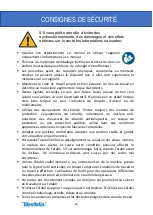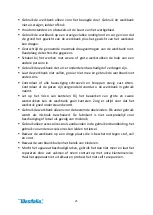
16
5.
The rear leg (7) can be used to lift the work bench into the folded position. It
is also possible to lift the work bench in the folded position with the carrying
handle (5) at the rear (see Fig. J).
Operation
Clamping / locking (see Fig. K)
Place the workpiece against the fixed jaw (1) on the front.
Slide the moving jaw (4) against the workpiece. The moving jaw can be
moved by hand or with the foot pedal.
Slide the lock / unlock button (17) down to lock.
Press the foot pedal (13) down to secure the workpiece securely.
Loosening / unlocking
(see Fig. L)
Slide the lock / unlock button (17) up.
Press the foot pedal (13) down until it “clicks”
Slide the moving jaw (4) back.
Note: Apply the same pressure on the foot pedal when unlocking as when
locking.
Warning: Support the workpiece so that it does not fall when the workpiece is
unlocked.
Clamping on one side of the jaw
(see Fig. M)
Large workpieces or workpieces with a different shape can in some cases only
be fixed on one side of the jaws. Avoid excessive use of clamping force.
Clamping square workpieces
(see Fig. N)
The jaw pads (2, 3) are equipped with horizontal and vertical grooves for
clamping square tubes and angled workpieces.
Clamping large objects
(clamping range> 450 mm) (see Fig. O)
For clamping large workpieces, the moving jaw can be reversed so that the
clamping range is increased to 956 mm:
• Slide the moving jaw (4) out of the rail.
• Turn the moving jaw 180° and slide the jaw back into the rail.
• The clamping range between 450 mm and 500 mm must be bridged by
means of a spool of at least 50 mm wide, for example a piece of wood or
similar solid material.
















































